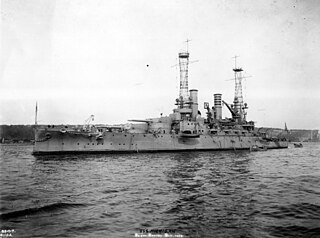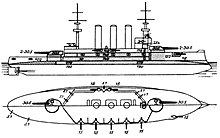
USS Delaware (BB-28) was a dreadnought battleship of the United States Navy, the lead ship of her class. She was laid down at Newport News Shipbuilding in November 1907, launched in January 1909, and completed in April 1910. The sixth ship to be named for the First State, Delaware was armed with a main battery of ten 12-inch (305 mm) guns all on the centerline, making her the most powerful battleship in the world at the time of her construction. She was also the first battleship of the US Navy to be capable of steaming at full speed for 24 continuous hours without suffering a breakdown.

USS Louisiana (BB-19) was a Connecticut-class battleship of the United States Navy. She was the second member of the class of six pre-dreadnought battleships, and the third ship to carry her name. Louisiana was laid down in February 1903, launched in August 1904, and commissioned in June 1906. She was a 16,000-long-ton (16,000 t) battleship capable of 19 knots. Her main armament consisted of four 12-inch (305 mm) guns supported by a mixed secondary battery of 7 in (178 mm) and 8 in (203 mm) guns.

USS Alabama (BB-8) was an Illinois-class pre-dreadnought battleship built for the United States Navy. She was the second ship of her class, and the second to carry her name. Her keel was laid down in December 1896 at the William Cramp & Sons shipyard, and she was launched in May 1898. She was commissioned into the fleet in October 1900. The ship was armed with a main battery of four 13-inch (330 mm) guns and she had a top speed of 16 knots.

USS Nebraska (BB-14) was a Virginia-class pre-dreadnought battleship of the United States Navy, the second of five members of the class, and the first ship to carry her name. She was built by the Moran Brothers shipyard in Seattle, Washington, with her keel laying in July 1902 and her launching in October 1904. The completed ship was commissioned into the US Navy in July 1907. The ship was armed with an offensive battery of four 12-inch (305 mm) guns and eight 8-inch (203 mm) guns, and she was capable of a top speed of 19 knots.

New Hampshire (BB-25) was the sixth and final Connecticut-class pre-dreadnought battleship, the last vessel of that type built for the United States Navy. Like most contemporary battleships, she was armed with an offensive armament that consisted of four large-caliber 12-inch (305 mm) guns and several medium-caliber 7 and 8-inch guns. The ship was laid down in May 1905, launched in June 1906, and commissioned in March 1908, a little over a year after the revolutionary all-big-gun HMS Dreadnought rendered ships like New Hampshire obsolescent.

USS Maine (BB-10), the lead ship of her class of pre-dreadnought battleships, was the second ship of the United States Navy to be named in honor of the 23rd state. Maine was laid down in February 1899 at the William Cramp & Sons shipyard in Philadelphia. She was launched in July 1901 and commissioned into the fleet in December 1902. She was armed with a main battery of four 12-inch (305 mm) guns and could steam at a top speed of 18 knots.

USS New Jersey (BB-16) was the fourth of five Virginia-class battleships of the United States Navy, and the first ship to carry her name. She was laid down at the Fore River Shipbuilding Company in Quincy, Massachusetts, in May 1902, launched in November 1904, and commissioned into the fleet in May 1906. The ship was armed with an offensive battery of four 12-inch (305 mm) guns and eight 8-inch (203 mm) guns, and she was capable of a top speed of 19 knots.

USS North Dakota (BB-29) was a dreadnought battleship of the United States Navy, the second member of the Delaware class, her only sister ship being Delaware. North Dakota was laid down at the Fore River Shipyard in December 1907, was launched in November 1908, and commissioned into the US Navy in April 1910. She was armed with a main battery of ten 12-inch (305 mm) guns and was capable of a top speed of 21 kn. North Dakota was the first vessel of the US Navy to be named after the 39th state.

USS Virginia (BB-13) was a United States Navy pre-dreadnought battleship, the lead ship of her class. She was the fifth ship to carry her name. Virginia was laid down in May 1902 at the Newport News Shipbuilding and Dry Dock Company in Newport News, Virginia, was launched in April 1904, and was commissioned into the fleet in May 1906. The ship was armed with an offensive battery of four 12-inch (305 mm) guns and eight 8-inch (203 mm) guns, and she was capable of a top speed of 19 knots.

USS Kentucky (BB-6), was the second and final Kearsarge-class pre-dreadnought battleship built for the United States Navy in the 1890s. Designed for coastal defense, the Kearsarge-class battleships had a low freeboard and heavy armor. The ships carried an armament of four 13-inch (330 mm) and four 8-inch (203 mm) guns in an unusual two-story turret arrangement. The Newport News Shipbuilding Company of Virginia laid down her keel on 30 June 1896. She was launched on 24 March 1898 and was commissioned on 15 May 1900.

USS Ohio (BB-12), a Maine-class pre-dreadnought battleship, was the third ship of her class and the third ship of the United States Navy to be named for the 17th state. She was laid down at the Union Iron Works shipyard in San Francisco in April 1899, was launched in May 1901, and was commissioned into the fleet in October 1904. She was armed with a main battery of four 12-inch (305 mm) guns and could steam at a top speed of 18 knots.

USS Illinois (BB-7) was a pre-dreadnought battleship built for the United States Navy. She was the lead ship of the Illinois class, and was the second ship of the U.S. Navy to be named for the 21st state. Her keel was laid down in February 1897 at the Newport News Shipbuilding & Dry Dock Company, and she was launched in October 1898. She was commissioned in September 1901. The ship was armed with a main battery of four 13-inch (330 mm) guns and she had a top speed of 16 knots.

USS Rhode Island (BB-17) was the last of five Virginia-class battleships built for the United States Navy, and was the second ship to carry her name. She was laid down in May 1902, launched in May 1904, and commissioned into the Atlantic Fleet in February 1906. The ship was armed with an offensive battery of four 12-inch (305 mm) guns and eight 8-inch (203 mm) guns, and she was capable of a top speed of 19 knots.

USS Wisconsin (BB-9), an Illinois-class pre-dreadnought battleship, was the first ship of the United States Navy to be named for the 30th state. She was the third and final member of her class to be built. Her keel was laid down in February 1897 at the Union Iron Works in San Francisco, and she was launched in November 1898. The completed ship was commissioned into the fleet in February 1901. The ship was armed with a main battery of four 13-inch (330 mm) guns and she had a top speed of 16 knots.

USS Minnesota (BB-22), the fifth of six Connecticut-class pre-dreadnought battleships, was the first ship of the United States Navy in honor of the 32nd state. She was laid down at the Newport News Shipbuilding Company of Newport News, Virginia in October 1903, launched in April 1905, and commissioned into the US fleet in March 1907, just four months after the revolutionary British battleship HMS Dreadnought entered service. Minnesota was armed with a main battery of four 12-inch (305 mm) guns and a secondary battery of twenty 7 and 8 in guns, unlike Dreadnought, which carried an all-big-gun armament that rendered ships like Minnesota obsolescent.

USS Michigan (BB-27), a South Carolina-class battleship, was the second ship of the United States Navy to be named in honor of the 26th state. She was the second member of her class, the first dreadnought battleships built for the US Navy. She was laid down in December 1906, launched in May 1908, and commissioned into the fleet 4 January 1910. Michigan and South Carolina were armed with a main battery of eight 12-inch (305 mm) guns in superfiring twin gun turrets; they were the first dreadnoughts to feature this arrangement.

USS Georgia (BB-15) was a United States Navy Virginia-class battleship, the third of five ships of the class. She was built by the Bath Iron Works in Maine, with her keel laid in August 1901 and her launching in October 1904. The completed battleship was commissioned into the fleet in September 1906. The ship was armed with an offensive battery of four 12-inch (305 mm) guns and eight 8-inch (203 mm) guns, and she was capable of a top speed of 19 knots.

USS Kansas (BB-21) was a US Connecticut-class pre-dreadnought battleship, the fourth of six ships in the class. She was the second ship of the United States Navy named Kansas, but the only one named in honor of the state of Kansas. The ship was launched in August 1905 and commissioned into the fleet in April 1907. Kansas was armed with a main battery of four 12-inch (305 mm) guns and was capable of a top speed of 18 kn.

The Illinois class was a group of three pre-dreadnought battleships of the United States Navy commissioned at the beginning of the 20th century. The three ships, Illinois, Alabama, and Wisconsin, were built between 1896 and 1901. They were transitional ships; they incorporated advances over preceding designs, including the first modern gun turrets for the main battery, and new rapid-firing secondary guns, but they were also the last American battleships to feature dated technologies like fire-tube boilers and Harvey armor. They were armed with a main battery of four 13-inch (330 mm) guns in two twin turrets, supported by a secondary battery of fourteen 6 in (150 mm) guns. The ships had a designed speed of 16 knots, though they exceeded that speed by a significant margin.

The three Maine-class battleships—Maine, Missouri, and Ohio—were built at the turn of the 20th century for the United States Navy. Based on the preceding Illinois class, they incorporated several significant technological advances over the earlier ships. They were the first American battleships to incorporate Krupp cemented armor, which was stronger than Harvey armor, smokeless powder, which allowed for higher-velocity guns and water-tube boilers, which were more efficient and lighter. The Maines were armed with four 12-inch (305 mm) guns and sixteen 6-inch (152 mm) guns, and they could steam at a speed of 18 knots, a significant increase over the Illinois class.























